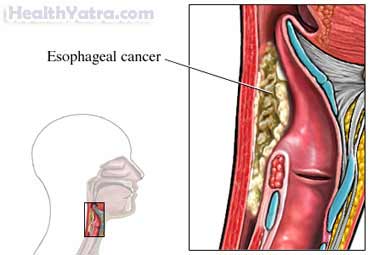تعريف
This is surgery to remove the esophagus. The esophagus is the tube that runs from the mouth to the stomach.
أسباب هذا الإجراء
Esophagectomy may be used to treat:
- Esophageal cancer
- Benign tumors and cysts of the esophagus
- Other esophageal abnormalities

المضاعفات المحتملة
If you are planning to have esophagectomy, your doctor will review a list of possible complications, which may include:
- نزيف
- Blood clots
- العدوى
- Soreness in throat
- Adverse reaction to the anesthesia
- Leaks from the internal suture line
- نوبة قلبية
تشمل العوامل التي قد تزيد من خطر حدوث مضاعفات ما يلي:
- Pre-existing heart or lung conditions
- سن متقدم
- السمنة
- التدخين
- مرض السكري
- الإفراط في تناول الكحول
تأكد من مناقشة هذه المخاطر مع طبيبك قبل الإجراء.
ما يمكن توقعه
قبل الإجراء
قد يقوم طبيبك بما يلي:
- اختبار بدني
- اختبارات الدم والبول
- Chest x-ray —a test that uses radiation to take pictures of structures inside the body
- Ultrasound—a test that uses sound waves to examine structures in the body
- CT scan —a type of x-ray that uses a computer to take pictures of structures in the body
- MRI scan —a test that uses magnetic waves to make pictures of structures in the body
- Upper endoscopy —a thin, lighted tube inserted down the throat to examine the esophagus
- Place a feeding tube into your small intestine (may be done during the esophagectomy)
المؤدية إلى الإجراء الخاص بك:
- التحدث مع طبيبك عن الأدوية الخاصة بك. قد يطلب منك التوقف عن تناول بعض الأدوية تصل إلى أسبوع واحد قبل العملية مثل:
- الأدوية المضادة للالتهابات (مثل الأسبرين)
- سيولة الدم, مثل كلوبيدوجريل (بلافيكس) أو الوارفارين (الكومادين)
- Arrange for someone to drive you home from the hospital and to help you at home.
- تناول وجبة خفيفة في الليلة السابقة. لا تأكل أو تشرب أي شيء بعد منتصف الليل.
- Your doctor may ask you to:
- Use an enema to clear your intestines
- اتبع حمية غذائية خاصة.
- Take antibiotics or other medicines.
- Shower using antibacterial soap the night before the surgery.
التخدير
General anesthesia will be used. It will block any pain and keep you asleep through the surgery. A tube will be placed in your windpipe to help you breathe.
وصف الإجراء
Depending on the area that needs to be removed, the doctor will make an incision in the neck or abdomen using one of these techniques:
- One large incision (open procedure)—The doctor will locate the diseased area and remove it.
- Several small incisions ( robot-assisted procedure)—A tiny camera and small surgical instruments will be inserted through the incisions. Looking at the esophagus on a monitor, the doctor will locate and remove the diseased area.
A “replacement” esophagus will be formed with part of the stomach. The remainder of the esophagus will be attached to this new esophagus. In some cases, lymph nodes in the area will also be removed. One or more chest tubes will be placed to drain fluids. Lastly, the incisions will be closed with stitches or staples.
كم من الوقت سيستغرق ؟
About six hours
كم هو مؤلم ؟
You will feel pain as the anesthesia wears off. Ask your doctor about medicine to help with the pain.
متوسط الإقامة في المستشفى
This procedure is done in a hospital setting. The usual length of stay is 1-2 weeks. Your doctor may choose to keep you longer if complications arise.
رعاية ما بعد العملية
You will not be able to eat or drink anything during the first week after surgery. You will get nutrition through a feeding tube. Within 7-14 days, you will have a swallowing test to check for leaks. If there are no leaks, your diet will gradually progress from clear liquids to soft, solid meals. You will probably be able to return to a normal diet after about a month. Your stomach will be smaller, so you will need to eat smaller portions.
You will also need to do deep breathing exercises. You may be given an incentive spirometer. This is a device to help you breath deeply.
- Your doctor will encourage you to walk every day.
- Avoid heavy lifting for 6-8 weeks.
- اسأل طبيبك حول, عندما هي آمنة للاستحمام, السباحة, أو نقع في الماء.
استدعاء الطبيب
بعد مغادرة المستشفى ، اتصل بطبيبك في حالة حدوث أي مما يلي:
- علامات الإصابة, بما في ذلك حمى وقشعريرة
- احمرار أو تورم أو ألم متزايد أو نزيف شديد أو أي إفرازات من موقع الشق
- الغثيان و / أو القيء الذي لا يمكنك السيطرة عليه بالأدوية التي أعطيت لك بعد الجراحة ، أو التي تستمر لأكثر من يومين بعد الخروج من المستشفى
- ألم لا يمكنك السيطرة عليه بالأدوية التي أعطيت لك
- ألم أو حرقة أو إلحاح أو كثرة التبول أو نزيف مستمر في البول
- السعال، ضيق التنفس، أو ألم في الصدر
- Constipation or diarrhea
- ألم و/أو تورم في قدميك، أو ساقيك، أو ساقيك
إذا كنت تعتقد أن لديك حالة طارئة ، فاتصل بالمساعدة الطبية على الفور.
